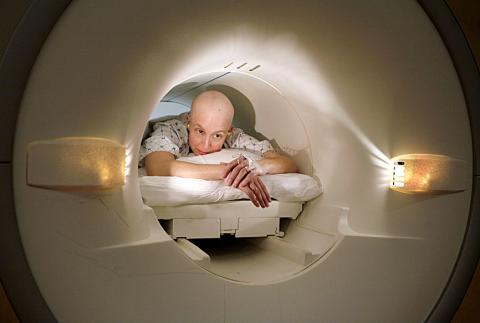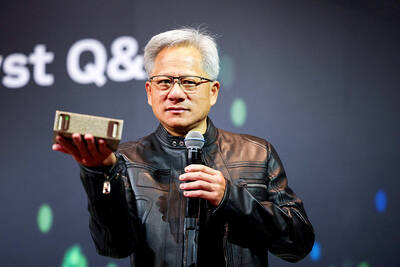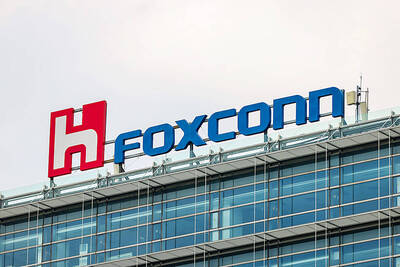A 90-year-old helium reservoir in Texas could shut down next month, causing disruptions and raising costs for makers of high-tech products from magnetic resonance imaging (MRI) scanners to semiconductors, and threaten medical treatments and research.
More than 100 organizations, universities and companies, including Siemens, Philips, Samsung and General Electric, wrote to the US Congress last week urging it to keep the reservoir open or risk a disruption to the US economy, putting millions of jobs at risk.
Helium, best known as a party gas for filling balloons and making the voice squeaky, is also needed for aerospace and defense industries as well as smartphones, flatscreen TVs, medical equipment and deep-sea diving tanks.

Photo: Reuters
The gas, which is the second-most abundant element in the universe, is difficult to capture and store, making the US reservoir a vital source.
The US Federal Helium Reserve has been providing about a third of global crude helium and 40 percent of US supply. However, this will be turned off after Oct. 7 unless Congress acts to extend its life.
The reserve near Amarillo in Texas was opened in 1925 as a supply of helium for airships and it then provided helium in the Cold War and the Space Race.
By 1995 the reserve was US$1.4 billion in debt as a result of earlier purchases of helium from private producers. The debt is due to finish being repaid to the US Treasury by the end of this month and under current law, funding to the federal program will then stop, terminating operations.
Congress would have to amend the law or pass new legislation to keep the reserve going.
Helium refiners have already been raising prices in anticipation of its closure.
GE Healthcare, which uses helium to make MRI scanners, said the spot price of liquid helium has jumped to US$25 to US$30 per liter fro US$8 last year.
“There is no question the situation is challenging. We are having to look at different sources of helium, not just the US supply, and have invested US$17 million in a plant to capture waste helium,” said Richard Hausmann, president and chief executive of GE Healthcare’s global Magnetic Resonance business.
The firm uses about 5.5 million liters of helium a year in its production facility in South Carolina and another 6 million liters a year servicing MR systems at US sites.
Using other gases instead can result in poorer quality goods or require costly and unproven refitting of processing or manufacturing machinery.
“If supplies were disrupted for a significant period it could even impact the overall economy,” Rodney Morgan, vice president of procurement at computer memory manufacturer Micron Technology, told a hearing of the US House Committee on Natural Resources earlier this year.
Helium remains liquid at extremely low temperatures, making it ideal for cooling superconducting magnets used in electronics manufacturing and in magnetic resonance imaging (MRI) machines that help to diagnose diseases.
The cost of helium already makes up to 30 to 40 percent of research budgets, so further price rises could be crippling.
Some university research projects in Britain were put on hold and brain-scanning equipment was shut down last year due to a helium shortage.
Helium is a byproduct of natural gas production, but once it is released into the atmosphere it cannot be captured. Demand for helium has risen, driven particularly by Asia’s booming manufacturing industry.
Annual global production of helium was nearly 175 million cubic meters last year, the US Geological Survey said, but demand is forecast to rise to more than 300 million cubic meters by 2030.
“Even if the reserve didn’t go offline, things aren’t good at the moment. There is definitely around a 3 percent shortage. Everything produced is being snapped up,” said Richard Clarke, resources consultant and former helium specialist at the Culham Centre for Fusion Energy in Oxford.
The US reserve is important because other countries’ supplies, such as Qatar, Russia and Algeria, are still too erratic or not large enough to cover the US shortfall.
Qatar could potentially supply about 20 to 25 percent of world helium when its two large liquefaction plants reach full capacity. Air Liquide started up a 38 million cubic meters per year plant last month, but it is not yet operating at full potential.
Algeria already supplies 10 to 15 percent of global helium, but could potentially provide more if it recovered helium from natural gas export pipelines to southern Europe.
Russia accounts for about 3.6 percent of global helium production, according to Ernst & Young, but it needs to build a lot of gas infrastructure in Siberia to enable its output to equal that of the US by 2022 to 2025.
“October 7 is D-day for helium,” Clarke said. “It may be that US President [Barack] Obama has to pass a continuing resolution to keep operations going.”

SEEKING CLARITY: Washington should not adopt measures that create uncertainties for ‘existing semiconductor investments,’ TSMC said referring to its US$165 billion in the US Taiwan Semiconductor Manufacturing Co (TSMC, 台積電) told the US that any future tariffs on Taiwanese semiconductors could reduce demand for chips and derail its pledge to increase its investment in Arizona. “New import restrictions could jeopardize current US leadership in the competitive technology industry and create uncertainties for many committed semiconductor capital projects in the US, including TSMC Arizona’s significant investment plan in Phoenix,” the chipmaker wrote in a letter to the US Department of Commerce. TSMC issued the warning in response to a solicitation for comments by the department on a possible tariff on semiconductor imports by US President Donald Trump’s

‘FAILED EXPORT CONTROLS’: Jensen Huang said that Washington should maximize the speed of AI diffusion, because not doing so would give competitors an advantage Nvidia Corp cofounder and chief executive officer Jensen Huang (黃仁勳) yesterday criticized the US government’s restrictions on exports of artificial intelligence (AI) chips to China, saying that the policy was a failure and would only spur China to accelerate AI development. The export controls gave China the spirit, motivation and government support to accelerate AI development, Huang told reporters at the Computex trade show in Taipei. The competition in China is already intense, given its strong software capabilities, extensive technology ecosystems and work efficiency, he said. “All in all, the export controls were a failure. The facts would suggest it,” he said. “The US

The government has launched a three-pronged strategy to attract local and international talent, aiming to position Taiwan as a new global hub following Nvidia Corp’s announcement that it has chosen Taipei as the site of its Taiwan headquarters. Nvidia cofounder and CEO Jensen Huang (黃仁勳) on Monday last week announced during his keynote speech at the Computex trade show in Taipei that the Nvidia Constellation, the company’s planned Taiwan headquarters, would be located in the Beitou-Shilin Technology Park (北投士林科技園區) in Taipei. Huang’s decision to establish a base in Taiwan is “primarily due to Taiwan’s talent pool and its strength in the semiconductor

French President Emmanuel Macron has expressed gratitude to Hon Hai Precision Industry Co (鴻海精密) for its plan to invest approximately 250 million euros (US$278 million) in a joint venture in France focused on the semiconductor and space industries. On his official X account on Tuesday, Macron thanked Hon Hai, also known globally as Foxconn Technology Group (富士康科技集團), for its investment projects announced at Choose France, a flagship economic summit held on Monday to attract foreign investment. In the post, Macron included a GIF displaying the national flag of the Republic of China (Taiwan), as he did for other foreign investors, including China-based